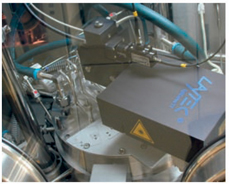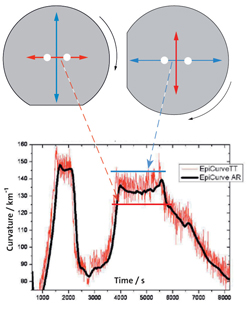
| Home | About Us | Contribute | Bookstore | Advertising | Subscribe for Free NOW! |
| News Archive | Features | Events | Recruitment | Directory |
News
7 September 2010
First single-port installation of LayTec EpiCurveTT on showerhead reactor
LayTec GmbH of Berlin, Germany, which provides in-situ optical metrology systems for thin-film processes, has announced the first installation of its EpiCurveTT tool on a showerhead metal-organic chemical vapor deposition (MOCVD) system on only one viewport — specifically, on an Aixtron Close Coupled Showerhead (CCS) MOCVD system at Fraunhofer Institute for Applied Solid State Physics (IAF) in Freiburg, Germany.
 In the past, since viewports of such systems are so small, LayTec has used two separate windows: one for the measurement of curvature and one for measurement of temperature and reflectance. Now, due to improved design, all three parameters can be measured through one standard AIX CCS viewport.
In the past, since viewports of such systems are so small, LayTec has used two separate windows: one for the measurement of curvature and one for measurement of temperature and reflectance. Now, due to improved design, all three parameters can be measured through one standard AIX CCS viewport.
Figure 1: EpiCurveTT on a AIX CCS system at the Fraunhofer Institute for Applied Solid State Physics (IAF) in Freiburg, Germany.
Dr Chunyu Wang and his team at IAF will use the tool to control the growth of gallium nitride (GaN) on silicon substrates. The simultaneous in-situ monitoring of wafer temperature, reflectance and curvature will be used to engineer the stress in the epilayers. "The new sensor will help us to get flat and crack-free GaN layers on Si substrates for future sophisticated electronic devices," comments Wang.
EpiCurveTT AR for advanced curvature resolution in Planetary reactors
 LayTec recently launched the EpiCurveTT AR (advanced resolution) for measurement of the aspherical curvature component during epitaxial growth in Planetary and other gas-foil rotation MOCVD systems where the azimuth of the rotating wafers is unknown. The standard EpiCurveTT without AR measures randomly along either the major axis (larger bow — blue arrow in Figure 2) or the minor axis (smaller bow — red arrow). Since the phase of rotation is unknown in a Planetary reactor, the signal looks 'noisy' (red line in Figure 3), oscilating between the maximum and the minimum of the azimuthal aspherical bow.
LayTec recently launched the EpiCurveTT AR (advanced resolution) for measurement of the aspherical curvature component during epitaxial growth in Planetary and other gas-foil rotation MOCVD systems where the azimuth of the rotating wafers is unknown. The standard EpiCurveTT without AR measures randomly along either the major axis (larger bow — blue arrow in Figure 2) or the minor axis (smaller bow — red arrow). Since the phase of rotation is unknown in a Planetary reactor, the signal looks 'noisy' (red line in Figure 3), oscilating between the maximum and the minimum of the azimuthal aspherical bow.
Figure 2 (top): Measurement
principle with a 1-dimensional
detection system
(EpiCurveTT without
advanced resolution). Figure 3 (bottom): Curvature measurements
with conventional
EpiCurveTT (red) and
EpiCurveTT AR (black):
the new tool eliminates
the aspherical distortion
in the signal.
The new AR tool measures curvature along two perpendicular axes and eliminates second-order azimuthal bowing effects. In Figure 3, the black line shows the curvature signal of the new EpiCurveTT AR sensor. The signal-to-noise ratio of the tool with advanced resolution improves the curvature signal from ±8km–1 (red line) to ±0.2km–1 (black line) and measures only the main curvature component by eliminating the aspherical contribution.
Also, even the quantity of asphericity can be extracted by analysing the advanced resolution signal.
See: LayTec Company Profile
![]() Search: LayTec In-situ optical metrology MOCVD Aixtron
Search: LayTec In-situ optical metrology MOCVD Aixtron
Visit: www.laytec.de
For more on MOCVD: Latest issue of Semiconductor Today